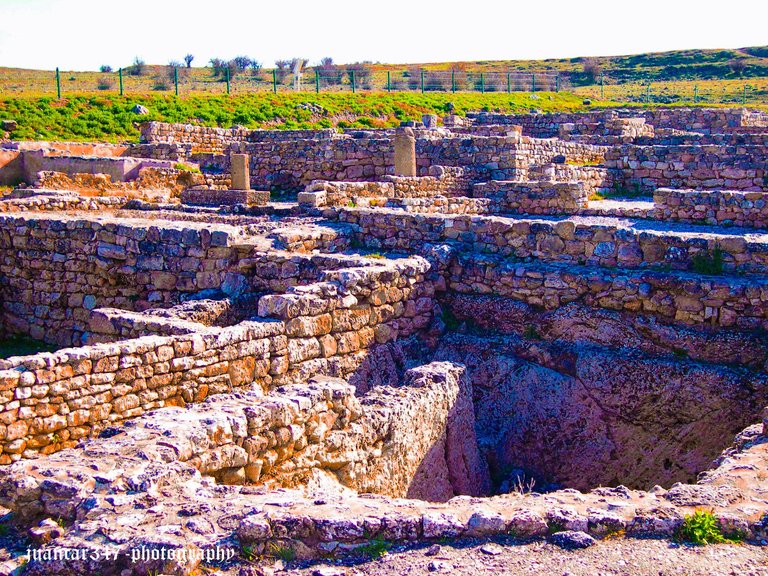[ENG-SPN] Uxama: The City That Dreamed of Being a Myth / Uxama: la ciudad que soñó con ser Mito

Iberians, Romans, Visigoths, Muslims, Jews, and Christians were, as far as these ancient ruins were concerned, something more or less similar to that mythical alliance of Hellenistic states, which, under the frustrated command of Agamemnon, the cunning of Ulysses, and the murderous ferocity of Achilles turned the ruins of legendary Troy into the fantastic dream of modern archaeologists.

We are talking about the melancholic ruins of a city, Uxama, which, possibly unintentionally, became the Genesis—with Chesterton's permission and his fixation on every self-respecting biography—of one of the most flourishing cities on this side of what in medieval times was considered the border of the Duero River, or, in other words, that imaginary line or no man's land that separated those two ambivalent Spains, the Christian and the Muslim: El Burgo de Osma.

What remains of one of those metaphorical Aeneas who left old Uxama behind on the road to exile, San Pedro de Osma, is the memory of his magnificent polychrome tomb, lying in the cloister of a cathedral where the Black Virgin of the Thorn is venerated. The towers, rising above walls that not even the Trojan horse of time could completely demolish, continue to face that solitary place, where the underground cisterns still receive the rainwater that momentarily frees them from their silent ostracism, a few meters before reaching the cliff, where a solitary Muslim watchtower centuries ago stopped sending signals that, in many cases, like the title of Rainer Maria Rilke's famous novel, simply said: all quiet on the western front.

Íberos, romanos, visigodos, musulmanes, judíos y cristianos fueron, en lo que a estas milenarias ruinas se refiere, algo más o menos parecido a esa mítica alianza de estados helenos, que, bajo el frustrado mando de Agamenón, la astucia de Ulises y la ferocidad homicida de Aquiles hicieron de las ruinas de la legendaria Troya el sueño fantástico de los arqueólogos modernos.

Hablamos de las melancólicas ruinas de una ciudad, Uxama, que, posiblemente, sin pretenderlo, se convirtió en el Génesis -con el permiso de Chesterton y su fijación por toda biografía que se precie- de una de las más florecientes ciudades a este lado de lo que en tiempos medievales se consideraba como la frontera del Duero, o lo que viene a ser lo mismo, de esa línea imaginaria o tierra de nadie, que separaba aquellas dos Españas ambivalentes, como fueron, la cristiana y la musulmana: El Burgo de Osma.

Queda, de uno de aquellos metafóricos Eneas que dejaron atrás la vieja Uxama camino del exilio, San Pedro de Osma, el recuerdo de su magnífico sepulcro policromado, yaciendo en el claustro de una catedral donde se venera a la Virgen Negra del Espino y cuyas torres, elevándose por encima de unas murallas que ni siquiera consiguió derribar del todo el caballo de Troya del tiempo, continúan orientadas hacia ese solitario lugar, donde todavía las cisternas subterráneas reciben el agua de lluvia que las libera momentáneamente de su silencioso ostracismo, algunos metros antes de llegar al risco, donde una solitaria atalaya musulmana hace siglos que dejó de enviar unas señales, que, en muchos casos, al igual que el título de la famosa novela de Rainer María Rilke, tan sólo venían a decir aquello de: sin novedad en el frente.

NOTICE: Both the text and the accompanying photographs are my exclusive intellectual property and are therefore subject to my copyright.
AVISO: Tanto el texto, como las fotografías que lo acompañan, son de mi exclusiva propiedad intelectual y por lo tanto, están sujetos a mis Derechos de Autor.

Wow this is nice!
Thank-you
https://x.com/lee19389/status/1967732732907360762
#hive #posh
The history of all these interesting places is also quite interesting and our knowledge always increases by reading it.
Our knowledge and our perception. Letting ourselves be carried away by what these places convey is also a luxury for the senses.
Wow! The way you describe towers, cisterns and the cliff gives the city a quiet, almost magical presence, like it’s still speaking across the centuries.
It's what it really speaks to. Everything in that setting encourages meditation, allowing oneself to be carried away, not only by reverie, but also by one's own feelings, by what the whole thing conveys to you as you delve deeper into it. That's, ultimately, the beauty of travel: it unleashes sensations and encourages us to always look beyond what we see with the naked eye. Best regards.
Absolutely! It’s amazing how a place can invite not just observation, but introspection. It’s an experience that goes far beyond what we simply see.🤗